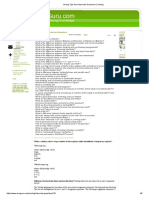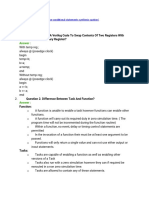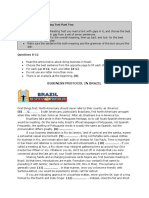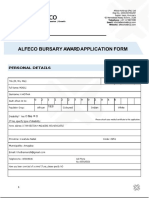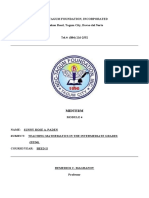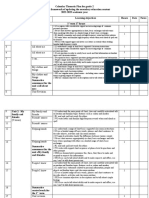5/16/2011 Verilog interview Questions & answers
Verilog interview Questions & answers for FPGA & ASIC.
Verilog FAQ
Verilog interview Questions
Synthesis FAQ
Verilog interview Questions page 1 Verilog interview Questions Page 2
Digital FAQ Verilog interview Questions page 3 Verilog interview Questions page 4
Timing FAQ Ads by Google Verilog Simulation VHDL VHDL FPGA Design VHDL 7 Segment
ASIC FAQ
1) Write a verilog code to swap contents of two registers with and without a temporary register?
Cmos FAQ
With temp reg ;
Misc FAQ
always @ (posedge clock)
Home begin
temp=b;
b=a;
a=temp;
end
Without temp reg;
always @ (posedge clock)
begin
a <= b;
b <= a;
end
Click to view more
CFD for Today & Tomorrow ANSYS CFD Insight Leadership Series View the white paper & video www.ansys.com/C…
Verilog Simulation & Test Verilog Simulator with automatic test bench generation. www.syncad.com
Verilog Training Training by Industry Experts Worldwide Locations Reasonable Cost xerenet.com/services/trainingservices
2) Difference between blocking and non-blocking?(Verilog interview questions that is most commonly asked)
The Verilog language has two forms of the procedural assignment statement: blocking and non-blocking. The two are
distinguished by the = and <= assignment operators. The blocking assignment statement (= operator) acts much like in
traditional programming languages. The whole statement is done before control passes on to the next statement. The non-
blocking (<= operator) evaluates all the right-hand sides for the current time unit and assigns the left-hand sides at the end
of the time unit. For example, the following Verilog program
// testing blocking and non-blocking assignment
module blocking;
reg [0:7] A, B;
initial begin: init1
A = 3;
#1 A = A + 1; // blocking procedural assignment
B = A + 1;
$display("Blocking: A= %b B= %b", A, B ); A = 3;
#1 A <= A + 1; // non-blocking procedural assignment
asic.co.in/…/verilog_interview_question… 1/7
�5/16/2011 Verilog interview Questions & answers
B <= A + 1;
#1 $display("Non-blocking: A= %b B= %b", A, B );
end
endmodule
produces the following output:
Blocking: A= 00000100 B= 00000101
Non-blocking: A= 00000100 B= 00000100
The effect is for all the non-blocking assignments to use the old values of the variables at the beginning of the current time
unit and to assign the registers new values at the end of the current time unit. This reflects how register transfers occur in
some hardware systems.
blocking procedural assignment is used for combinational logic and non-blocking procedural assignment for sequential
Click to view more
FPGA Textbooks Verilog & VHDL Digital Design Texts using Digilent FPGA kits. Low cost. www.digilentinc.com
Lipidomic Services Lipoprotein lipidomics and molecular lipid quantification www.zora.fi
SystemC Synthesis Silicon-Proven Behavioral Synthesis & Design from C++/SystemC www.ForteDS.com
Tell me about verilog file I/O?
OPEN A FILE
integer file;
file = $fopenr("filename");
file = $fopenw("filename");
file = $fopena("filename");
The function $fopenr opens an existing file for reading. $fopenw opens a new file for writing, and $fopena opens a new
file for writing where any data will be appended to the end of the file. The file name can be either a quoted string or a reg
holding the file name. If the file was successfully opened, it returns an integer containing the file number (1..MAX_FILES)
or NULL (0) if there was an error. Note that these functions are not the same as the built-in system function $fopen
which opens a file for writing by $fdisplay. The files are opened in C with 'rb', 'wb', and 'ab' which allows reading and
writing binary data on the PC. The 'b' is ignored on Unix.
CLOSE A FILE
integer file, r;
r = $fcloser(file);
r = $fclosew(file);
The function $fcloser closes a file for input. $fclosew closes a file for output. It returns EOF if there was an error,
otherwise 0. Note that these are not the same as $fclose which closes files for writing.
Click to view more
Best VHDL Tool All the Eclipse Coolness for VHDL. Free for Students and Professors! www.sigasi.com
Ebiquity Data-driven Media & Marketing Insight. Improve Media ROI www.ebiquity.com
SCADA Software SCADA software for Data Acquisition Test & Control any Process. www.amplicon.com
3) Difference between task and function?
asic.co.in/…/verilog_interview_question… 2/7
�5/16/2011 Verilog interview Questions & answers
Function:
A function is unable to enable a task however functions can enable other functions.
A function will carry out its required duty in zero simulation time. ( The program time will not be incremented during the
function routine)
Within a function, no event, delay or timing control statements are permitted
In the invocation of a function their must be at least one argument to be passed.
Functions will only return a single value and can not use either output or inout statements.
Tasks:
Tasks are capable of enabling a function as well as enabling other versions of a Task
Tasks also run with a zero simulation however they can if required be executed in a non zero simulation time.
Tasks are allowed to contain any of these statements.
A task is allowed to use zero or more arguments which are of type output, input or inout.
A Task is unable to return a value but has the facility to pass multiple values via the output and inout statements .
4) Difference between inter statement and intra statement delay?
//define register variables
reg a, b, c;
//intra assignment delays
initial
begin
a = 0; c = 0;
b = #5 a + c; //Take value of a and c at the time=0, evaluate
//a + c and then wait 5 time units to assign value
//to b.
end
//Equivalent method with temporary variables and regular delay control
initial
begin
a = 0; c = 0;
temp_ac = a + c;
#5 b = temp_ac; //Take value of a + c at the current time and
//store it in a temporary variable. Even though a and c
//might change between 0 and 5,
//the value assigned to b at time 5 is unaffected.
end
5) What is delta simulation time?
6) Difference between $monitor,$display & $strobe?
These commands have the same syntax, and display text on the screen during simulation. They are much less convenient
than waveform display tools like cwaves?. $display and $strobe display once every time they are executed, whereas
$monitor displays every time one of its parameters changes.
The difference between $display and $strobe is that $strobe displays the parameters at the very end of the current
simulation time unit rather than exactly where it is executed. The format string is like that in C/C++, and may contain
format characters. Format characters include %d (decimal), %h (hexadecimal), %b (binary), %c (character), %s (string)
and %t (time), %m (hierarchy level). %5d, %5b etc. would give exactly 5 spaces for the number instead of the space
needed. Append b, h, o to the task name to change default format to binary, octal or hexadecimal.
Syntax:
$display (“format_string”, par_1, par_2, ... );
$strobe (“format_string”, par_1, par_2, ... );
$monitor (“format_string”, par_1, par_2, ... );
asic.co.in/…/verilog_interview_question… 3/7
�5/16/2011 Verilog interview Questions & answers
7) What is difference between Verilog full case and parallel case?
A "full" case statement is a case statement in which all possible case-expression binary patterns can be matched to a case
item or to a case default. If a case statement does not include a case default and if it is possible to find a binary case
expression that does not match any of the defined case items, the case statement is not "full."
A "parallel" case statement is a case statement in which it is only possible to match a case expression to one and only one
case item. If it is possible to find a case expression that would match more than one case item, the matching case items
are called "overlapping" case items and the case statement is not "parallel."
8) What is meant by inferring latches,how to avoid it?
Consider the following :
always @(s1 or s0 or i0 or i1 or i2 or i3)
case ({s1, s0})
2'd0 : out = i0;
2'd1 : out = i1;
2'd2 : out = i2;
endcase
in a case statement if all the possible combinations are not compared and default is also not specified like in example
above a latch will be inferred ,a latch is inferred because to reproduce the previous value when unknown branch is
specified.
For example in above case if {s1,s0}=3 , the previous stored value is reproduced for this storing a latch is inferred.
The same may be observed in IF statement in case an ELSE IF is not specified.
To avoid inferring latches make sure that all the cases are mentioned if not default condition is provided.
9) Tell me how blocking and non blocking statements get executed?
Execution of blocking assignments can be viewed as a one-step process:
1. Evaluate the RHS (right-hand side equation) and update the LHS (left-hand side expression) of the blocking
assignment without interruption from any other Verilog statement. A blocking assignment "blocks" trailing assignments in
the same always block from occurring until after the current assignment has been completed
Execution of nonblocking assignments can be viewed as a two-step process:
1. Evaluate the RHS of nonblocking statements at the beginning of the time step. 2. Update the LHS of nonblocking
statements at the end of the time step.
10) Variable and signal which will be Updated first?
Signals
11) What is sensitivity list?
The sensitivity list indicates that when a change occurs to any one of elements in the list change, begin…end statement
inside that always block will get executed.
12) In a pure combinational circuit is it necessary to mention all the inputs in sensitivity disk? if yes, why?
Yes in a pure combinational circuit is it necessary to mention all the inputs in sensitivity disk other wise it will result in pre
and post synthesis mismatch.
13) Tell me structure of Verilog code you follow?
A good template for your Verilog file is shown below.
// timescale directive tells the simulator the base units and precision of the simulation
`timescale 1 ns / 10 ps
asic.co.in/…/verilog_interview_question… 4/7
�5/16/2011 Verilog interview Questions & answers
module name (input and outputs);
// parameter declarations
parameter parameter_name = parameter value;
// Input output declarations
input in1;
input in2; // single bit inputs
output [msb:lsb] out; // a bus output
// internal signal register type declaration - register types (only assigned within always statements). reg register variable 1;
reg [msb:lsb] register variable 2;
// internal signal. net type declaration - (only assigned outside always statements) wire net variable 1;
// hierarchy - instantiating another module
reference name instance name (
.pin1 (net1),
.pin2 (net2),
.
.pinn (netn)
);
// synchronous procedures
always @ (posedge clock)
begin
.
end
// combinatinal procedures
always @ (signal1 or signal2 or signal3)
begin
.
end
assign net variable = combinational logic;
endmodule
14) Difference between Verilog and vhdl?
Compilation
VHDL. Multiple design-units (entity/architecture pairs), that reside in the same system file, may be separately compiled if
so desired. However, it is good design practice to keep each design unit in it's own system file in which case separate
compilation should not be an issue.
Verilog. The Verilog language is still rooted in it's native interpretative mode. Compilation is a means of speeding up
simulation, but has not changed the original nature of the language. As a result care must be taken with both the
compilation order of code written in a single file and the compilation order of multiple files. Simulation results can change
by simply changing the order of compilation.
Data types
VHDL. A multitude of language or user defined data types can be used. This may mean dedicated conversion functions
are needed to convert objects from one type to another. The choice of which data types to use should be considered
wisely, especially enumerated (abstract) data types. This will make models easier to write, clearer to read and avoid
unnecessary conversion functions that can clutter the code. VHDL may be preferred because it allows a multitude of
language or user defined data types to be used.
Verilog. Compared to VHDL, Verilog data types a re very simple, easy to use and very much geared towards modeling
hardware structure as opposed to abstract hardware modeling. Unlike VHDL, all data types used in a Verilog model are
defined by the Verilog language and not by the user. There are net data types, for example wire, and a register data type
called reg. A model with a signal whose type is one of the net data types has a corresponding electrical wire in the implied
modeled circuit. Objects, that is signals, of type reg hold their value over simulation delta cycles and should not be
confused with the modeling of a hardware register. Verilog may be preferred because of it's simplicity.
Design reusability
asic.co.in/…/verilog_interview_question… 5/7
�5/16/2011 Verilog interview Questions & answers
VHDL. Procedures and functions may be placed in a package so that they are avail able to any design-unit that wishes to
use them.
Verilog. There is no concept of packages in Verilog. Functions and procedures used within a model must be defined in
the module. To make functions and procedures generally accessible from different module statements the functions and
procedures must be placed in a separate system file and included using the `include compiler directive.
15) What are different styles of Verilog coding I mean gate-level,continuous level and others explain in
detail?
16) Can you tell me some of system tasks and their purpose?
$display, $displayb, $displayh, $displayo, $write, $writeb, $writeh, $writeo.
The most useful of these is $display.This can be used for displaying strings, expression or values of variables.
Here are some examples of usage.
$display("Hello oni");
--- output: Hello oni
$display($time) // current simulation time.
--- output: 460
counter = 4'b10;
$display(" The count is %b", counter);
--- output: The count is 0010
$reset resets the simulation back to time 0; $stop halts the simulator and puts it in interactive mode where the
user can enter commands; $finish exits the simulator back to the operating system
17) Can you list out some of enhancements in Verilog 2001?
In earlier version of Verilog ,we use 'or' to specify more than one element in sensitivity list . In Verilog 2001, we can use
comma as shown in the example below.
// Verilog 2k example for usage of comma
always @ (i1,i2,i3,i4)
Verilog 2001 allows us to use star in sensitive list instead of listing all the variables in RHS of combo logics . This removes
typo mistakes and thus avoids simulation and synthesis mismatches,
Verilog 2001 allows port direction and data type in the port list of modules as shown in the example below
module memory (
input r,
input wr,
input [7:0] data_in,
input [3:0] addr,
output [7:0] data_out
);
18)Write a Verilog code for synchronous and asynchronous reset?
Synchronous reset, synchronous means clock dependent so reset must not be present in sensitivity disk eg:
always @ (posedge clk )
begin if (reset)
. . . end
Asynchronous means clock independent so reset must be present in sensitivity list.
Eg
Always @(posedge clock or posedge reset)
begin
if (reset)
. . . end
asic.co.in/…/verilog_interview_question… 6/7
�5/16/2011 Verilog interview Questions & answers
19) What is pli?why is it used?
Programming Language Interface (PLI) of Verilog HDL is a mechanism to interface Verilog programs with programs
written in C language. It also provides mechanism to access internal databases of the simulator from the C program.
PLI is used for implementing system calls which would have been hard to do otherwise (or impossible) using Verilog
syntax. Or, in other words, you can take advantage of both the paradigms - parallel and hardware related features of
Verilog and sequential flow of C - using PLI.
20) There is a triangle and on it there are 3 ants one on each corner and are free to move along sides of
triangle what is probability that they will collide?
Ants can move only along edges of triangle in either of direction, let’s say one is represented by 1 and another by 0, since
there are 3 sides eight combinations are possible, when all ants are going in same direction they won’t collide that is 111
or 000 so probability of not collision is 2/8=1/4 or collision probability is 6/8=3/4
asic.co.in/…/verilog_interview_question… 7/7


